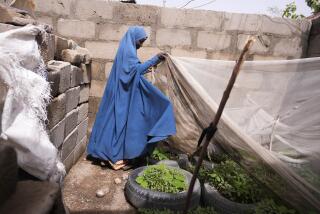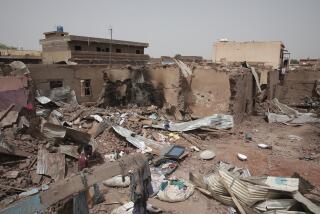Season of Destruction Returns to Niger
GEDERAM, Niger — The rainy season brings a breathtaking verdant beauty to Sakina Idi’s village in southern Niger, but it also fills her heart with a cold dread. Last year, one of her children, a 2-year-old girl, died in the wet season. The year before, another child died. The year before that, two of her children died during the rains, a month apart.
Now, facing the worst harvest in years and surviving on the bitter berries and tasteless grasses that grow in the surrounding sandy soil, Idi fears for her two young daughters, and another child unborn.
“In the rainy season I just sit and I feel very unhappy. It’s hurting me, but I cannot do anything,” Idi said, sitting on a stretch of damp sand with the girls, two of her five surviving children. She’s all they have -- her husband died last year.
During the wet season, Niger’s greenery is cruelly deceptive. Even in some of the hardest-hit villages things look strangely normal on the surface. But the food in the market is double the usual price, too expensive for the poor. The crops look green but won’t be ready for one or two months, and it’s difficult to predict whether the harvest will succeed or fail.
So much depends on the rains. In Gederam, despite the lushness surrounding the village, elders survey the struggling millet crop with troubled eyes. There had been no rain for 20 days until Friday, when the skies finally opened.
“It looks bad. We are so afraid,” said one elder, Yelwa Bishi, 50. “There’s been hardly any rain, and there are insects in the ground that are eating the seeds. If the crop fails, it’s just death.”
He said there had been no real crop for three years and that a locust plague last September -- which devastated crops across West Africa, triggering Niger’s hunger crisis -- had destroyed the harvest.
“We have no cattle, we have no goats, no sheep and no horses. We sold everything to buy food,” Bishi said. “Many families have left. We have no money to buy millet and nothing to sell. This village has already died.”
In Gederam, 30 miles north of the city of Zinder, 15 children have been buried in the last year, twice the normal number.
General free food distributions by the World Food Program have not yet begun here, but spokesman Marcus Prior said they were expected in coming days. He said the area surrounding Zinder would be among the first to get help. The WFP’s target is to help 2.5 million people, but it is now delivering limited food to the 40,000 most vulnerable.
The area around Zinder, a harsh, stony landscape infamous for the paucity and bad quality of its water, is among the most severely affected by hunger. Every year in March and April, the taps in Zinder slow to a painful dribble or run dry.
Water is so scare here that in 1927, the French colonial government shifted the capital from Zinder to Niamey because of the problem.
When the taps dry out in Zinder, the advent of trucks selling water sparks panic rushes. But for the poor the cost is too high, and they must rely on well water full of toads that tastes of salt and algae and makes many children sick.
In villages such as Gederam, the dry season earlier this year was also a difficult time, because of the crop devastation after the locusts. Without international help, it would be even worse.
“The future is bad, because after the rains, everything will dry out and I am worried,” said Idi, the widow.
Prior, the WFP spokesman, said 500 tons of food were in the country for free distribution.
“We are bringing food in all the time,” he said. “We are obviously doing as much as we can to target the most vulnerable within those distributions first.”
The bitter yellow berries that people in villages north of Zinder survive on have to be soaked for a week to remove some of the strong taste. Women boil and knead them into an unappetizing brown paste. The children hate the food, which is their only hope of survival.
“The children refuse to eat it and cry,” Idi said, “so we have to be clever to trick them into eating it. You take a small spoon and when they refuse it, you try to play a little to try to coax them to accept it.”
Most of southern Niger is suffering. In Zongo Bahi village, west of the Zinder region, the real troubles began when the locusts came. It was night when the cloud swept over the village one September night, a blacker stain against the dark sky, bringing a whirring sound like a deafening shrill of competing moped engines. Then it rained locusts, all over Suleiman Bahi and his family, who were sleeping outside. Women cried and children yelled out in fear.
For three days, nearly everyone in the village ran around the crops waving branches, desperately fighting to protect the millet plants.
“But then I saw it was useless,” said Bahi, who is about 40. “I wanted to cry. I was so scared my heart was breaking. I was wondering about the future of my village, thinking that all the people would be scattered.”
For a month the locusts crawled over Bahi’s crop and the surrounding trees as he watched them in impotent hatred. When they disappeared, all the grain was eaten and the few surviving leaves were gray and dry.
“I used to be a rich man, but last year I became a poor man,” Bahi said.
Late Friday afternoon, on the road leading from Zongo Bahi, women walked slowly home, scattered along the sandy track like colorful butterflies. They had traveled to the village of Gabi, two hours away on foot, in the hope of getting food handouts.
One of them, Hassana Maname, 40, had walked for hours each of the last eight days to villages such as Gabi where Doctors Without Borders was distributing food for families with malnourished children. Turned away empty-handed because her child is thin but not malnourished, she tried to maintain her dignity, but tears of despair and anger filled her eyes.
“I did not cry out loudly. I just cried a few tears softly to myself,” she said as her 18-month son, Muttaka, flopped on her back. She has six others at home and five in the grave, dead from the effects of diarrhea. Of six women on the road, four had lost between one and five children in recent years.
Two of them had been given food by Doctors Without Borders and four had not, because their children were not malnourished, even though they said they had no food at home.
Some critics say that Niger’s food security committee, on which the main aid agencies sit, was slow to move to free food distributions after the crisis arose, for fear of distorting the market. Others point to the slow response by donors.
“I think that clearly there has been a failure to react in time to what were clear early warning signals,” Prior said. “There is an early warning system, and the government made a very early appeal followed up by ourselves and other U.N. agencies trying to alert the world to the reality of a bad year ahead.”
Oxfam and the British government say they will push for the establishment of a $1-billion U.N. emergency reserve fund at a U.N. meeting in September to handle future crises quickly.
*
(BEGIN TEXT OF INFOBOX)
How to help
U.S. Fund for Unicef
www.unicefusa.org/niger(800) 4-UNICEF
333 E. 38th St.
New York, NY 10016
*
Doctors Without Borders
www.doctorswithoutborders.org(888) 392-0392
P.O. Box 1856
Merrifield, VA 22216-8056
International Red Cross and Red Crescent Societies
www.ifrc.org
*
Oxfam America
www.oxfamamerica.org(800) 77-OXFAM
P.O. Box 1211
Albert Lea, MN 56007-1211
More to Read
Sign up for Essential California
The most important California stories and recommendations in your inbox every morning.
You may occasionally receive promotional content from the Los Angeles Times.










